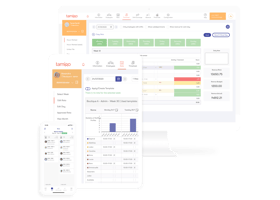“If you can’t measure it, you can’t manage it.”
Nine words that perfectly capture the utility of KPIs.
It’s why they've become transformative for data-driven growth strategies — in theory anyway. Because identifying the right ones, and then measuring them long term, is easier said than done!
At tamigo, KPIs have been a part of our solution since we started back in 2006. And we’ve helped a lot of businesses use theirs successfully. That includes enterprise retailers, looking to edge ahead in a competitive sector.
In this article, we’ll take a look at relevant KPIs for retail businesses. And how a solution like tamigo can help you measure them.
What are KPIs?
It’s worth defining KPIs because they’re so often confused with goals.
Goal: A high-level business objective, typically set by management. For example: ‘Grow overall revenue by 10% this year’.
KPI (Key Performance Indicator): A measurable value that tracks progress towards your goal. It needs to be quantifiable and objective. For example: ‘Sales per Employee’.
Every department or employee within a company can have their own set of KPIs. It’s then their responsibility to own them — monitoring and taking action to improve their quality if needed.
It’s worth noting that KPIs are useful for all kinds of businesses processes. Sales is far from the only one. Within our solution, we have numerous categories. These include efficiency and optimisation, cost control and HR management.
You might be interested in: How Bijou Brigitte save their German store managers hours of reporting

Why are they important?
When used correctly, KPIs have so much to give. Here's why:- They keep your business on track. As opposed to gut feeling, these are hard numbers that get to the heart of your company’s performance. You can see where you’re succeeding and where you’re falling short.
- They let you be proactive. The whole point of KPIs is that they’re measurable: on an hourly, daily and monthly basis. You won’t reach the end of the year only to discover that you’re way off your goals. Instead, you get real-time insights to drive productivity and operational efficiency.
- They give your staff a new focus. Annual business targets can seem disconnected from day-to-day work. KPIs draw the line towards those bigger goals, demonstrating the concrete ways in which everyone’s contributing.
What are the main KPIs in retail?
Supermarkets, clothes shops, department stores... Retail is far from homogenous, and each business will have its own way of measuring success. But there are some core KPIs which always prove useful.
We’ve worked with enterprise-size retailers across Europe, helping them optimise their workforce management. Here are the KPIs for retail we recommend they focus on.
Productivity
Sales generated per productive hour.
This KPI gives a clear view of staff performance during those times that they’re actively generating sales (e.g., serving customers as opposed to taking part in training).
Off-floor Percentage
The number of unproductive hours compared to total hours.
Unproductive hours includes things like administrative time for managers. Or when staff are stocking shelves or cleaning. Are they spending too much time on these tasks — and are there inefficient processes which could be streamlined?
Sales per Total Hours
Sales generated per all hours (both productive & unproductive).
This grants you an overview of stores’ peak hours. It helps managers schedule staff more efficiently to cover your busiest (and slowest) periods.
Staff Turnover
Number of leavers compared to working employees.
If employee turnover is higher in one of your stores than another, then it could be the manager needs more support or training. Or it’s time to turn a critical eye to your onboarding and development programs.
Labour Costs
Staff costs based on hours and wage rates.
Wage costs are always a significant chunk of retail operating budgets. Especially when overtime comes in to play. An automated solution for shift planning, that's fully integrated with HR and payroll systems, gives you greater control over costs. Learn how design brand Bolia tackled their labour costs using tamigo.
Wage Percentage
Amount of labour costs compared to revenue.
A wage percentage that’s trending upwards signals a decrease in staff productivity. Taking a look at your approach to employee engagement is one of the first actions to consider.
Absence Percentage
Number of absence hours compared to all hours.
Retail workforces recording a lot of no-shows are likely burnt-out or de-motivated. It might also be caused by inefficient timekeeping (e.g. staff forgetting to clock in).

The challenges of tracking them
Once you’ve settled on your KPIs of choice, there’s a few more hurdles to clear. Here's some frustrations you can face:
- Siloed information. The numbers informing KPIs for retail are drawn from a lot of different places: time clocks, POS systems, spreadsheets, etc. Bringing all this data together is both time consuming and complex. Especially for enterprise retailers, whose many store managers have their own preferred ways of recording data.
- Lack of visibility. Do your sales assistants or managers know what their KPIs are? If KPIs aren’t a part of their 9 to 5 — viewable in the systems they use — they’re going to forget about them.
- Incorrect data. As anyone who’s ever filled out a spreadsheet knows, errors can creep in. Manual methods of data entry and calculations are also open to abuse — staff can report working more hours than they actually have. Measuring KPIs is pointless if your data is wrong to begin with.
Measuring KPIs for retail
Overcoming the challenges of KPIs begins with the systems you use. A workforce management (WFM) software brings these important metrics into sharper focus.
In tamigo, KPIs are:
- Transparent and collaborative. tamigo is an all-in-one solution, accessible by all departments and employees. Instead of being spread between five different systems, the numbers that Finance, HR and Operations need are in tamigo, ready to analyse and benchmark.
- Actionable. Every stakeholder in your company can view the KPIs relevant to them — on the pages in tamigo where they matter. For example, when managers are planning shifts, a ‘Budget hours’ KPI can be shown next to the schedule. And it will update as changes are made.
- Accurate. With its automations and user-friendly interface, tamigo helps cut down on data-entry mistakes. And its timeclock feature, tamigo Touch — which comes with optional geofencing functionality — ensures more accurate reporting of employee worked hours.
- Fully customisable. tamigo comes with in-built KPIs. These are ones that we’ve seen clients use again and again. But if you’re interested in other numbers, adding custom KPIs can be done directly in the solution. Choose how to define, calculate and display them. And, through tamigo's integrations, add a wealth of external data to the mix.
If you’re already a tamigo user, you can learn more about KPIs for retail in our Help Centre. And to learn more about our offering for retail companies, check out our dedicated retail page.





